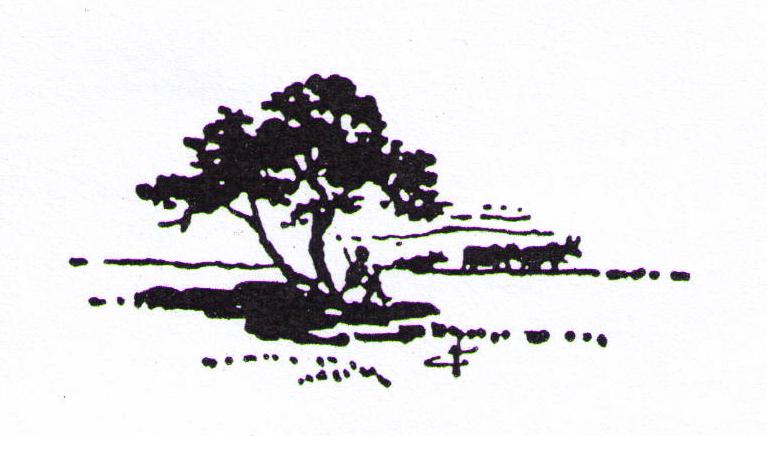The essay by the German indologist Moritz Winternitz was published in The Golden Book of Tagore, published on the occasion of the seventieth birthday of Rabindranath Tagore in 1931. The author is well-known for his three-volume study on History of Indian Literature (German Title: Geschichte der indischen Literatur, 3 vol., Leipzig 1905-1922). This reissued paper on Ahiṁsā presents, however, an unkonwn aspect of Moritz Winternitz' personality: It shows his sympathy for the doctrine of non-violence as represented by Mahatma Gandhi.
One of the foremost contributions of India to the moral progress of mankind is the idea and ideal of Ahiṁsā. It is often translated by 'non-violence', but the Indian term deserves, like Karma and Nirvāṇa, to be added to the vocabulary of Western languages. It is not often that the etymology of a word gives so full an explanation of its meaning, as in the case of Ahiṁsā. The verb hiṁs is a desiderative form of han, and therefore means 'to wish to slay, to hurt, to injure, to harm' and the substantive a-hiṁsā means 'not wishing to slay, to hurt, to injure, to harm.'
The history of Ahiṁsā begins with the Chāndogya-Upaniṣad (III, 17, 4) where the moral conduct of man is summarized in the words: tapo dānam ārjavam ahiṁsā satya-vacanam 'austerity, alms-giving, righteousness, Ahiṁsā and truthfulness.' According to the Yoga-sūtra (II; 30) Ahiṁsā is the first of the eight conditions for Yoga. In the Brahmanical Dharma-śāstras Ahiṁsā is prescribed as the first rule of a holy life for the Brahmacārin, the Snātaka, and the Sannyāsin, but it also heads the list of the duties of all castes in Manu's law-book (X, 63).
In the Mahābhārata we find the story of the shopkeeper Tulādhāra and the Brahman Jājali. The latter, a great Yogin, was standing in the forest, like a wooden post, without moving. A pair of birds came flying towards him, and built their nest in the dishevelled hair of his head, and he did not move until the she-bird bad laid eggs in the nest on his head, the eggs were hatched and the young birds were fledged and had flown away. After this mighty feat of asceticism he called out exultingly: 'I have achieved religious merit!' But he was told by a heavenly voice that he was not even equal to Tulādhāra, an honest shopkeeper in Benares. The great Yogin is quite disheartened, goes to Tulādhāra, and enquires of him as to wherein his renowned religious merit consists. Then Tulādhāra explains to him the eternal law of Ahiṁsā, which is known as the old doctrine, beneficial to all, the doctrine of love (maitra):'A manner of life which is combined with complete harmlessness, or only with slight harm, to all beings, that is the highest religion; in accordance with this I live, O Jājali [...]. If one fears no being, and no being fears one, if one has preference for nobody and hates nobody, then he becomes united with Brahman'.
It is, however, in Buddhism and especially in Jainism that Ahiṁsā as the highest moral law (ahiṁsā paramo dharmaḥ) is most strongly emphasized. We read in the Jaina scriptures:
'He should not kill, not cause others to kill, not consent to the killing of others. The Arhats and Bhagavats of the past, present, and future, all say thus, speak thus, declare thus, explain thus: no breathing, existing, living, sentient creatures should ever he slain, or treated with violence, or abused, or tormented, or harassed.'
'All beings hate pain, therefore one should not kill them. This is the quintessence of wisdom: not to kill anything.'
And in Buddhist Sutras it is said:
'As I am, so are these, as these are, so am I; identifying himself with others, let him not kill nor cause any one to kill.'
'Putting away the murder of that which lives, he abstains from destroying life. The cudgel and the sword he lays aside; and, full of modesty and pity, he is compassionate andkind to all creatures that have life.'
From a historical point of view, Ahiṁsā was at first, like tapas, the virtue of the perfect man, the ascetic, the saint, who had to practise it, in order that his soul may be purified and prepared for final emancipation. In course of time, probably under the indirect influence of Buddhists and Jainas, it came to be a general law of morality for all men, though there were always a great many ifs and buts to this 'general' law. The same law-books which teach Ahiṁsā as the first duty of all castes, also teach the Varnāśrama Dharma, according to which it is the Kṣatriya's duty to fight and to kill; and an ancient Hindu law-book says that the slaughter of beasts for sacrifice 'is no slaughter'. The Buddhist poet Mātṛceta, in his letter to the Mahārāja Kaniṣka, implores his royal friend to give up hunting, with the curious argument that since the king found sufficient practice in the use of arms in battle, why should he do harm to the wild creatures in the forest andat the same time to his own self? And even the Jaina author of Nīti-śāstra says: 'Calmness towards evil-doers is the ornament of ascetics, but not of kings'.
When we remember that, already in the hymns of the Ṛgveda, Indra, the lord of gods, is a great warrior and slayer of foes; that the Hindu Epics revel in descriptions of battle scenes; that Bhīṣma is not only a great sage and Yogin, but also a mighty killer of men; that the Bhagavad-gītā, the most sacred book of the Hindus, teaches a warrior's morality, in which slaughter is justified by God Kṛṣṇa saying that 'the soul never slays and is never slain', - and when we think of the most recent events in India, we shall hardly be able to agree with the late Deśabandhu C.R. Das who once said that he was opposed to revolutionary methods because 'violence is not part of our being as it is of Europe'.
In fact, violence is part of human nature in India, as it is in the West. Every living creature has a right to live, and no man has a right to destroy life. And yet, life is impossible without destruction of life. Looking at it from man's point of view, there is nothing as cruel and merciless as Nature, as 'God's beautiful creation' (as it is sometimes called), in which life and destruction of life - rarely an euthanasia, a beautyful and speedy passing away, more often a slow decay and destruction with infinite pains and tortures - are eternally interwoven.
And this is the great problem of Ahiṁsā. In a Jaina legend, a Sabara chief and his wife meet with a Sādhu who teaches them Ahiṁsā. One day the Sabara and his wife encounter a lion in the forest. The Sabara seizes his bow to shoot at the lion, but is reminded by his wife of the Sādhu's teaching. The Sabara chief throws his weapon aside, - and of course the couple are swallowed by the lion, but at the same moment they are reborn in the Saudharma Heaven as long-lived gods. Infidels as we are, we cannot be satisfied with such a solution of the Ahiṁsā problem.
Nay, the problem is there, and we have to face it. It is true that it is often necessary to destroy life, in order to save our own lives or a more valuable life, and to do harm and inflict suffering, in order to create some greater good for our people or for mankind. But it is required of us that we should sharpen our consciences, and should not lightly take life or inflict suffering on any living being, but that we should be at greatest pains to consider in every single case whether there is really an absolute necessity for killing or injuring. Only in such a case we are allowed to make ourselves guilty. For we are always loading guilt upon us whenever we inflict suffering on any living creature.
It is true that violence and hatred are natural, but it is no less true that love and sympathy are natural. And if we come to think of it, love is wise, and hatred is foolish, love alone is creative and hatred is destructive. It is an eternal truth that violence only creates violence again and can never bring peace. As it is said in the old Buddhist adage: 'Not by hatred is hatred appeased, by not-hatred hatred is appeased.'
Therefore, Ahiṁsā, the not-wishing to harm, remains a great moral ideal, however difficult it may be to achieve it fully. Though we may have to obey necessity and to make ourselves guilty, we can never cease to strive after this ideal. It may not always be possible to refrain from hurting, but it is possible to foster in us the will to non-hurting, the will to peace.
While everywhere in the world the goddess of violence is worshipped, and lives without number are sacrificed to her, there is one man in India, the Mahatma Gandhi who is holding up the old Indian ideal of Ahiṁsā, making it his political program. That this program has found so many followers among the masses of India goes far to prove how deeply this ancient moral doctrine has taken root in the soul of a great nation.
The Poet, whom we remember to-day in love and gratitude, [1] has said that the force of arms only reveals man's weakness, and he has said again that peace is true and not conflict, love is true and not hatred. When people in the West will learn these truths, when they will have learnt that there is not only truth and wisdom but also strength in love and Ahiṁsā, then and then only Western civilisation will be rescued from that utter ruin by which, in spite of an unheared of technical progress, it is threatened in our days.

 Moriz Winternitz
Moriz Winternitz